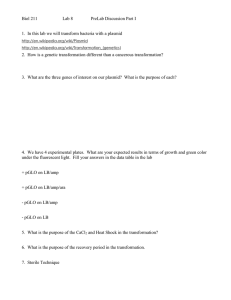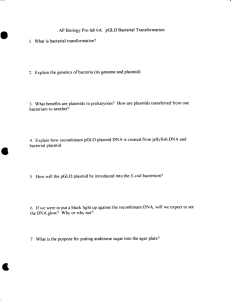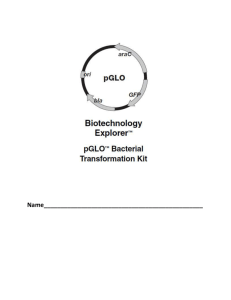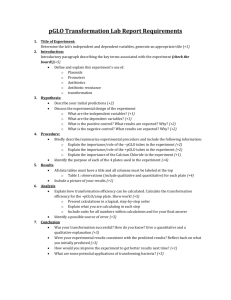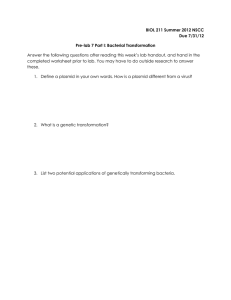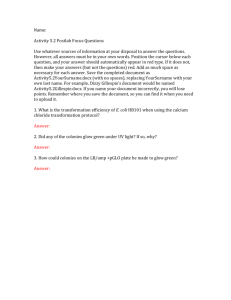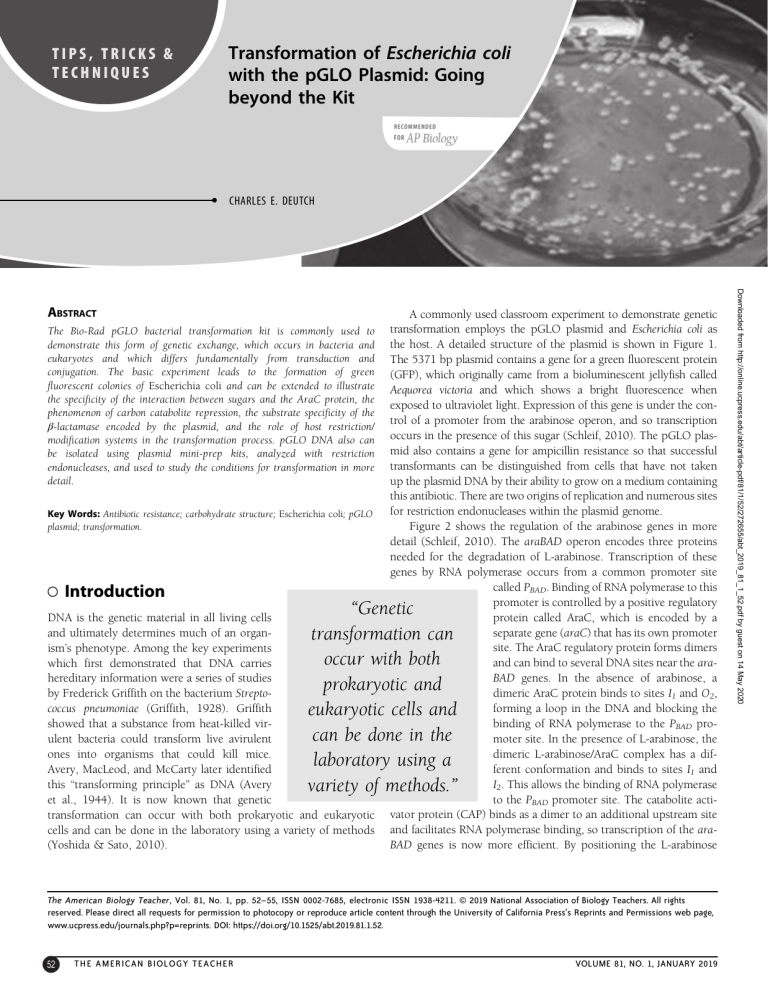
Transformation of Escherichia coli with the pGLO Plasmid: Going beyond the Kit TIPS, TRICKS & TECHNIQUES • CHARLES E. DEUTCH The Bio-Rad pGLO bacterial transformation kit is commonly used to demonstrate this form of genetic exchange, which occurs in bacteria and eukaryotes and which differs fundamentally from transduction and conjugation. The basic experiment leads to the formation of green fluorescent colonies of Escherichia coli and can be extended to illustrate the specificity of the interaction between sugars and the AraC protein, the phenomenon of carbon catabolite repression, the substrate specificity of the β-lactamase encoded by the plasmid, and the role of host restriction/ modification systems in the transformation process. pGLO DNA also can be isolated using plasmid mini-prep kits, analyzed with restriction endonucleases, and used to study the conditions for transformation in more detail. Key Words: Antibiotic resistance; carbohydrate structure; Escherichia coli; pGLO plasmid; transformation. Introduction A commonly used classroom experiment to demonstrate genetic transformation employs the pGLO plasmid and Escherichia coli as the host. A detailed structure of the plasmid is shown in Figure 1. The 5371 bp plasmid contains a gene for a green fluorescent protein (GFP), which originally came from a bioluminescent jellyfish called Aequorea victoria and which shows a bright fluorescence when exposed to ultraviolet light. Expression of this gene is under the control of a promoter from the arabinose operon, and so transcription occurs in the presence of this sugar (Schleif, 2010). The pGLO plasmid also contains a gene for ampicillin resistance so that successful transformants can be distinguished from cells that have not taken up the plasmid DNA by their ability to grow on a medium containing this antibiotic. There are two origins of replication and numerous sites for restriction endonucleases within the plasmid genome. Figure 2 shows the regulation of the arabinose genes in more detail (Schleif, 2010). The araBAD operon encodes three proteins needed for the degradation of L-arabinose. Transcription of these genes by RNA polymerase occurs from a common promoter site called PBAD. Binding of RNA polymerase to this promoter is controlled by a positive regulatory protein called AraC, which is encoded by a separate gene (araC) that has its own promoter site. The AraC regulatory protein forms dimers and can bind to several DNA sites near the araBAD genes. In the absence of arabinose, a dimeric AraC protein binds to sites I1 and O2, forming a loop in the DNA and blocking the binding of RNA polymerase to the PBAD promoter site. In the presence of L-arabinose, the dimeric L-arabinose/AraC complex has a different conformation and binds to sites I1 and I2. This allows the binding of RNA polymerase to the PBAD promoter site. The catabolite activator protein (CAP) binds as a dimer to an additional upstream site and facilitates RNA polymerase binding, so transcription of the araBAD genes is now more efficient. By positioning the L-arabinose “Genetic transformation can occur with both prokaryotic and eukaryotic cells and can be done in the laboratory using a variety of methods.” DNA is the genetic material in all living cells and ultimately determines much of an organism’s phenotype. Among the key experiments which first demonstrated that DNA carries hereditary information were a series of studies by Frederick Griffith on the bacterium Streptococcus pneumoniae (Griffith, 1928). Griffith showed that a substance from heat-killed virulent bacteria could transform live avirulent ones into organisms that could kill mice. Avery, MacLeod, and McCarty later identified this “transforming principle” as DNA (Avery et al., 1944). It is now known that genetic transformation can occur with both prokaryotic and eukaryotic cells and can be done in the laboratory using a variety of methods (Yoshida & Sato, 2010). The American Biology Teacher, Vol. 81, No. 1, pp. 52–55, ISSN 0002-7685, electronic ISSN 1938-4211. © 2019 National Association of Biology Teachers. All rights reserved. Please direct all requests for permission to photocopy or reproduce article content through the University of California Press’s Reprints and Permissions web page, www.ucpress.edu/journals.php?p=reprints. DOI: https://doi.org/10.1525/abt.2019.81.1.52. 52 THE AMERICAN BIOLOGY TEACHER VOLUME 81, NO. 1, JANUARY 2019 Downloaded from http://online.ucpress.edu/abt/article-pdf/81/1/52/272655/abt_2019_81_1_52.pdf by guest on 14 May 2020 ABSTRACT promoter site in front of the gene for the green fluorescent protein in the pGLO plasmid, GFP will be formed when the bacteria are grown in the presence of L-arabinose. The materials for the classroom transformation experiment with the pGLO plasmid using E. coli HB101 as the host are sold by Bio-Rad Laboratories (Hercules, California, USA; catalog no. 1660003EDU) and are widely marketed as part of its Explorer program for Advanced Placement (AP) high school students and lower-level university students. In addition to the basic kit, Bio-Rad sells supplementary kits for the purification of the green fluorescent protein by chromatography (catalog no. 1660005EDU) and for its separation from other E. coli proteins by SDS-polyacrylamide gel electrophoresis (catalog no. 1660013EDU). The kits have extensive student study guides and work very reliably. Here, I describe some extensions of the pGLO transformation experiment that can be used to explore aspects of the system in more detail and to demonstrate other biological concepts. Specificity of Carbohydrate–Protein Interactions A key feature of the pGLO system is the interaction between the sugar L-arabinose and the AraC protein. While many general biology, cell biology, biochemistry, and organic chemistry textbooks introduce carbohydrate structure, this topic is often difficult for students to follow. The standard protocol for pGLO transformation of E. coli strain HB101 calls for adding L-arabinose to LB medium at a concentration of 6 g L−1 along with ampicillin at a concentration of 100 mg L−1. To demonstrate the specificity of the interaction between sugars and the AraC protein, other carbohydrates can be added to the medium instead. For simplicity, I have made up standard LB agar plates and then spread them with 100 µL of a filter-sterilized 10 mg mL−1 solution THE AMERICAN BIOLOGY TEACHER Figure 2. Organization of the regulatory region adjacent to the promoter site for the araBAD genes (PBAD). In the absence of arabinose, a dimer of the AraC protein binds to sites I1 and O2, forming a loop in the DNA and blocking transcription. In the presence of L-arabinose, the modified AraC dimer binds to sites I1 and I2, which allows the binding of RNA polymerase and the catabolite activator protein (CAP) and subsequent transcription. of ampicillin and 100 µL to 200 µL of a filter-sterilized 60 mg mL−1 solution of a specific sugar. An LB suspension of E. coli HB101 known to contain the pGLO plasmid or the LB suspension from a standard transformation experiment is then streaked onto the plates for single colonies. After incubation for one to two days, the colonies are exposed to the simple UV light provided by BioRad and the presence or absence of fluorescence is noted. We have found that while L-arabinose is a good inducer of GFP expression, D-glucose, D-galactose, D-fructose, and L-rhamnose are not. Students can use a variety of sugars as a way of testing the importance of the number of carbons in the chain and the stereochemistry at each position. Additional sugars that might be included in their experiments are D-arabinose, L-glucose, D-fucose, and L-fucose. Catabolite Repression of GFP Formation In bacteria, the expression of many degradative genes is controlled by a process called carbon catabolite repression (Brückner & Titgemeyer, TRANSFORMATION OF ESCHERICHIA COLI WITH THE PGLO PLASMID 53 Downloaded from http://online.ucpress.edu/abt/article-pdf/81/1/52/272655/abt_2019_81_1_52.pdf by guest on 14 May 2020 Figure 1. Structure of the pGLO plasmid. The “ori” arrows show the direction of plasmid replication by DNA polymerases. The other arrows show the direction of transcription by RNA polymerase of the genes for AmpR (a β-lactamase), GFP (the green fluorescent protein), and AraC (the arabinose regulatory protein) from the adjacent promoter sites. Specificity of β-lactamase Activity The pGLO plasmid contains a gene (bla or ampR) for a protein called β-lactamase, which hydrolyzes antibiotics that have a β-lactam ring and makes host cells resistant to compounds like ampicillin. Expression of the β-lactamase gene is constitutive (that is, transcription is always on) from its own promoter site. This aspect of the system can allow an exploration of antibiotic structure and enzyme specificity. To do this, I have made up standard LB agar plates and had the students spread them with 100 µL aliquots of filter-sterilized 10 mg mL−1 solutions of various compounds. A suspension of HB101 containing the pGLO plasmid is then streaked onto the plates for single colonies and growth is observed after one to two days. We have found that the transformants can grow in the presence of ampicillin, penicillin G (benzyl penicillin), methicillin, and streptomycin. As a control, students should also test untransformed samples of E. coli HB101. These bacteria are resistant to streptomycin (due to a rpsL50 mutation in HB101) and, surprisingly, also resistant to methicillin. Conversely, both transformed and untransformed bacteria are inhibited by chloramphenicol and tetracycline because the enzyme has no effect on them. Students can expand on this experiment by using a variety of compounds in the penicillin and cephalosporin family. The effects of different antibiotics can also be demonstrated by spreading samples of an E. coli HB101 and HB101/pGLO cultures on LB plates and then placing disks containing different antibiotics on the agar surface. Bacteria that cannot degrade the antibiotic will show clear zones of inhibition after one to two days. Role of the Host Restriction/ Modification System in Transformation One of the important features of many bacteria is the presence of a restriction/modification system that can protect the organism from 54 THE AMERICAN BIOLOGY TEACHER foreign DNAs including those of viruses and other bacterial species (Murray, 2000). The system typically includes three proteins: the HsdS or specificity protein, the HsdM protein or DNA methylase, and the HsdR protein or restriction endonuclease. Methylation of host DNA during replication protects it from cleavage by the restriction endonuclease. Bacterial strains that are used for transformation and cloning experiments have been engineered to prevent cleavage of the plasmid DNA. E. coli HB101, the host strain used in the Bio-Rad pGLO kit, has a hsdS20 mutation and so no functional methylation or nuclease activities. To demonstrate the importance of this mutation in controlling the efficiency of transformation, students can attempt the transformation process with other E. coli strains. We have found that wild-type E. coli strains such as MG1655 or CGSC 5073 do not show transformation with pGLO using the standard protocol. On the other hand, other E. coli strains that have mutations affecting the restriction modification system such as JM109 (hsdR17, no restriction activity) and DH5α (hsdR17, no restriction activity) can be transformed with efficiencies comparable to that of HB101. Students may want to try the experiment with other E. coli strains or with bacteria of other species. Further Extensions Most of these extensions are relatively short and easy to do, and so several of them could be done in a single lab session. However, some instructors may want to combine them into a longer lab project that extends over several periods. Several examples of longer class projects involving mutagenesis of the GFP gene and the PCR reaction have been described previously (Bassiri, 2011; Wright & Newman, 2013). Although Bio-Rad Laboratories sells extra samples of the pGLO plasmid as part of their refill materials (1660405EDU, $39 for 20 µg), some instructors may want to have students prepare the plasmid themselves as part of an additional experiment using a commercially available plasmid DNA mini-prep kit. The DNA can then be examined by agarose gel electrophoresis and imaged using either ethidium bromide with a UV transilluminator or a blue stain and a white light illuminator. The DNA can then be cut with various restriction endonucleases and analyzed in more detail. Figure 1 shows the sites of cleavage by many restriction endonucleases. We have used the most commonly available enzymes EcoRI, HindIII, and BamHI, each of which has either one or two cleavage sites, respectively. The standard protocol for transformation of E. coli HB101 with pGLO uses a single type of transformation solution (50 mM CaCl2, pH 6.1) and a single form of heat shock (50 seconds at 42°C). There have been many investigations and modifications of this process, which involves the formation of competent cells, the uptake of DNA, and the recovery of transformed cells (e.g., Bergmans et al., 1981; Chan et al., 2013; Asif et al., 2017). The transformation of E. coli HB101 with pGLO provides a convenient system for investigating various aspects of this system, including the chemical composition of the transformation solution, the duration of the heat shock, the heat shock temperature, and the subsequent incubation temperature (Singh et al., 2010). Because the pGLO system is both accessible and open-ended, it is suitable for student projects at several different levels. Among the other questions that students may want to explore are (1) How can this system be used to demonstrate that DNA is the genetic material? (2) Which other plasmids can be introduced into E. coli? VOLUME 81, NO. 1, JANUARY 2019 Downloaded from http://online.ucpress.edu/abt/article-pdf/81/1/52/272655/abt_2019_81_1_52.pdf by guest on 14 May 2020 2002). For Gram-negative organisms like E. coli, this involves the Catabolite Activator Protein (CAP) and the nucleotide cyclic AMP (cAMP). cAMP is formed by the enzyme adenylyl cyclase, whose activity is regulated by the sugar D-glucose through the sugar phosphotransferase system. In the presence of D-glucose, less cAMP is formed and binding of the CAP/cAMP complex to the CAP-binding site adjacent to the araBAD promoter is reduced, limiting expression of the arabinose genes. Mosher (2002) previously described a student exercise using E. coli DH5αFIQ transformed with pGLO and LB agar plates containing 100 µg mL−1 ampicillin and 0.25% L-arabinose, 0.25% D-glucose, or both. I have found that students can explore the phenomenon of carbon catabolite repression using E. coli HB101 transformed with pGLO by spreading LB plates with different volumes (10 µL to 100 µL) of the 60 mg mL−1 solution of L-arabinose and with different volumes (10 µL to 100 µL) of the 60 mg mL−1 solution of D-glucose. The expression of pGLO from the arabinose promoter site in E. coli HB101 transformants is highly sensitive to the ratio of glucose to arabinose. There is a noticeable reduction in green fluorescence if there is more D-glucose than L-arabinose (100 µL compared to 10 µL). This project can be extended by looking at the effects of other sugars on the fluorescence of the colonies in transformants containing pGLO in the presence of low concentrations of L-arabinose. (3) Can pGLO be introduced into eukaryotic microbes such as yeast? (4) How can the intensity of the color of the GFP fluorescence be quantified? Many other kits are currently available from various suppliers (Bio-Rad Laboratories, Carolina Biological Supply Company, Ward’s Science, Edvotek) for use by students in AP and general biology courses. Instructors who have found experiments they like in these kits might want to develop similar extensions to those described here. Acknowledgments References Asif, A., Mohsin, H., Tanvir, R. & Rehman, Y. (2017). Revisiting the mechanism involved in calcium chloride induced bacterial transformation. Frontiers in Microbiology, 8, 2169. Avery, O.T., MacLeod, C.M. & McCarty, M. (1944). Studies on the chemical nature of the substance inducing transformation of pneumococcal types. Induction of transformation by desoxyribonucleic acid fraction isolated from pneumococcus Type III. Journal of Experimental Medicine, 79, 137–158. Bassiri, E.A. (2011). pGLO mutagenesis: a laboratory procedure in molecular biology for biology students. Biochemistry and Molecular Biology Education, 39, 432–439. THE AMERICAN BIOLOGY TEACHER CHARLES E. DEUTCH is Professor Emeritus in the School of Mathematical and Natural Sciences, Arizona State University West Campus, Glendale, AZ 85306, USA; email: charles.deutch@asu.edu. TRANSFORMATION OF ESCHERICHIA COLI WITH THE PGLO PLASMID 55 Downloaded from http://online.ucpress.edu/abt/article-pdf/81/1/52/272655/abt_2019_81_1_52.pdf by guest on 14 May 2020 I thank the students in BIO 318 (Genetics Laboratory) at Creighton University for trying out many of these extensions of the pGLO transformation experiment in the fall semesters of 2014 and 2015. I also thank the faculty and staff in the Department of Biology at Creighton University for their hospitality while I was there. Bergmans, H.E.N., van Die, I.M. & Hoekstra, W.P.M. (1981). Transformation in Escherichia coli: stages in the process. Journal of Bacteriology, 146, 564–570. Brückner, R. & Titgemeyer, F. (2002). Carbon catabolite repression in bacteria: choice of carbon source and autoregulatory limitation of sugar utilization. FEMS Microbiology Letters, 209, 141–148. Chan, W.T., Verma, C.S., Lane, D.P. & Gan, S.K. (2013). A comparison and optimization of methods and factors affecting the transformation of Escherichia coli. BioScience Reports, 33, e00086. Griffith, F. (1928). The significance of pneumococcal types. Journal of Hygiene, 27, 113–159. Mosher, R.H. (2002). Using pGLO to demonstrate the effects of catabolite repression on gene expression in Escherichia coli. Bioscene, 28, 17–23. Murray, N.E. (2000). Type I restriction systems: sophisticated molecular machines (a legacy of Bertani and Weigle). Microbiology and Molecular Biology Reviews, 64, 412–434. Schleif, R. (2010). AraC protein, regulation of the L-arabinose operon in Escherichia coli, and the light switch mechanism of AraC action. FEMS Microbiology Reviews, 34, 779–796. Singh, M., Yadav, A., Ma, X. & Maoah, E. (2010). Plasmid DNA transformation of Escherichia coli: effect of heat shock temperature, duration, and cold incubation of CaCl2 treated cells. International Journal of Biotechnology and Biochemistry, 6, 561–568. Wright, L.K., & Newman, D.L. (2013). Using PCR to target misconceptions about gene expression. Journal of Microbiology and Biology Education, 14, 93–100. Yoshida, N. & Sato, M. (2009). Plasmid uptake by bacteria: a comparison of methods and efficiencies. Applied Microbiology and Biotechnology, 83, 791–798.
